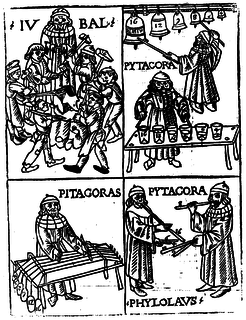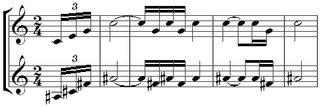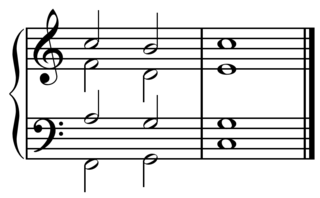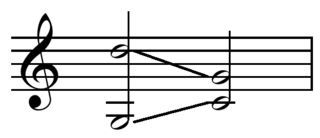Related Research Articles

In music, harmony is the process by which the composition of individual sounds, or superpositions of sounds, is analysed by hearing. Usually, this means simultaneously occurring frequencies, pitches, or chords.

Music theory is the study of the practices and possibilities of music. The Oxford Companion to Music describes three interrelated uses of the term "music theory". The first is the "rudiments", that are needed to understand music notation ; the second is learning scholars' views on music from antiquity to the present; the third a sub-topic of musicology that "seeks to define processes and general principles in music". The musicological approach to theory differs from music analysis "in that it takes as its starting-point not the individual work or performance but the fundamental materials from which it is built."

Polytonality is the musical use of more than one key simultaneously. Bitonality is the use of only two different keys at the same time. Polyvalence is the use of more than one harmonic function, from the same key, at the same time.
In music theory, the key of a piece is the group of pitches, or scale, that forms the basis of a music composition in classical, Western art, and Western pop music.
An octatonic scale is any eight-note musical scale. However, the term most often refers to the symmetric scale composed of alternating whole and half steps, as shown at right. In classical theory, this scale is commonly called the octatonic scale, although there are a total of 42 enharmonically non-equivalent, transpositionally non-equivalent eight-note sets.

A chord, in music, is any harmonic set of pitches/frequencies consisting of multiple notes that are heard as if sounding simultaneously. For many practical and theoretical purposes, arpeggios and broken chords, or sequences of chord tones, may also be considered as chords in the right musical context.

In music theory, the circle of fifths is a way of organizing the 12 chromatic pitches as a sequence of perfect fifths. If C is chosen as a starting point, the sequence is: C, G, D, A, E, B, F♯, C♯, A♭, E♭, B♭, F. Continuing the pattern from F returns the sequence to its starting point of C. This order places the most closely related key signatures adjacent to one another. It is usually illustrated in the form of a circle.
A secondary chord is an analytical label for a specific harmonic device that is prevalent in the tonal idiom of Western music beginning in the common practice period: the use of diatonic functions for tonicization.
A nonchord tone (NCT), nonharmonic tone, or embellishing tone is a note in a piece of music or song that is not part of the implied or expressed chord set out by the harmonic framework. In contrast, a chord tone is a note that is a part of the functional chord. Non-chord tones are most often discussed in the context of the common practice period of classical music, but they can be used in the analysis of other types of tonal music as well, such as Western popular music.
Succession is the act or process of following in order or sequence.

Tonality is the arrangement of pitches and/or chords of a musical work in a hierarchy of perceived relations, stabilities, attractions and directionality. In this hierarchy, the single pitch or triadic chord with the greatest stability is called the tonic. The root of the tonic chord forms the name given to the key; so in the key of C major, the note C is both the tonic of the scale and the root of the tonic chord. Simple folk music songs often start and end with the tonic note. The most common use of the term "is to designate the arrangement of musical phenomena around a referential tonic in European music from about 1600 to about 1910". Contemporary classical music from 1910 to the 2000s may practice or avoid any sort of tonality—but harmony in almost all Western popular music remains tonal. Harmony in jazz includes many but not all tonal characteristics of the European common practice period, sometimes known as "classical music".

In music theory, the concept of root is the idea that a chord can be represented and named by one of its notes. It is linked to harmonic thinking—the idea that vertical aggregates of notes can form a single unit, a chord. It is in this sense that one speaks of a "C chord" or a "chord on C"—a chord built from C and of which the note C is the root. When a chord is referred to in Classical music or popular music without a reference to what type of chord it is, it is assumed a major triad, which for C contains the notes C, E and G. The root need not be the bass note, the lowest note of the chord: the concept of root is linked to that of the inversion of chords, which is derived from the notion of invertible counterpoint. In this concept, chords can be inverted while still retaining their root.
In music theory, prolongation is the process in tonal music through which a pitch, interval, or consonant triad is able to govern spans of music when not physically sounding. It is a central principle in the music-analytic methodology of Schenkerian analysis, conceived by Austrian theorist Heinrich Schenker.

In music, consecutive fifths, or parallel fifths, are progressions in which the interval of a perfect fifth is followed by a different perfect fifth between the same two musical parts : for example, from C to D in one part along with G to A in a higher part. Octave displacement is irrelevant to this aspect of musical grammar; for example, parallel twelfths are equivalent to parallel fifths.

In music, consonance and dissonance are categorizations of simultaneous or successive sounds. Within the Western tradition, some listeners associate consonance with sweetness, pleasantness, and acceptability, and dissonance with harshness, unpleasantness, or unacceptability, although there is broad acknowledgement that this depends also on familiarity and musical expertise. The terms form a structural dichotomy in which they define each other by mutual exclusion: a consonance is what is not dissonant, and a dissonance is what is not consonant. However, a finer consideration shows that the distinction forms a gradation, from the most consonant to the most dissonant. In casual discourse, as Hindemith stressed, "The two concepts have never been completely explained, and for a thousand years the definitions have varied". The term sonance has been proposed to encompass or refer indistinctly to the terms consonance and dissonance.

Music theory analyzes the pitch, timing, and structure of music. It uses mathematics to study elements of music such as tempo, chord progression, form, and meter. The attempt to structure and communicate new ways of composing and hearing music has led to musical applications of set theory, abstract algebra and number theory.

Diatonic and chromatic are terms in music theory that are most often used to characterize scales, and are also applied to musical instruments, intervals, chords, notes, musical styles, and kinds of harmony. They are very often used as a pair, especially when applied to contrasting features of the common practice music of the period 1600–1900.
In music theory, an inversion is a type of change to intervals, chords, voices, and melodies. In each of these cases, "inversion" has a distinct but related meaning. The concept of inversion also plays an important role in musical set theory.

In music, klang is a term sometimes used to translate the German Klang, a highly polysemic word. Technically, the term denotes any periodic sound, especially as opposed to simple periodic sounds. In the German lay usage, it may mean "sound" or "tone", "musical tone", "note", or "timbre"; a chord of three notes is called a Dreiklang, etc.
Traditional sub-Saharan African harmony is a music theory of harmony in Sub-Saharan Africa music based on the principles of homophonic parallelism, homophonic polyphony, counter melody and ostinato-variation. Polyphony is common in African music and heterophony is a common technique as well. Although these principles of traditional African music are of Pan-African validity, the degree to which they are used in one area over another varies. Specific techniques that used to generate harmony in Africa are the "span process", "pedal notes", "Rhythmic harmony", "harmony by imitation", and "scalar clusters".
References
- ↑ Cucker, Felipe (2013). Manifold Mirrors: The Crossing Paths of the Arts and Mathematics, p. 191. Cambridge University. ISBN 9781107354494.
- ↑ Hijleh, Mark (2012). Towards a Global Music Theory: Practical Concepts and Methods for the Analysis of Music Across Human Cultures, chapter 4, [unpaginated]. Ashgate. ISBN 9781409461401.